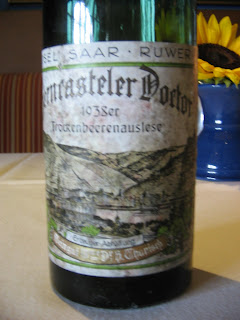
So, I have been thinking about my next blog post, which should be Part VII about the fabulous dinner that followed the first part of the TBA tasting on Saturday April 17. The dinner took place at Mille Fleurs in Rancho Santa Fe, where the tasting took place. I'll talk about the wonderful dishes we had at this dinner in the next post, but I'll take a sidebar here to rant a little about the wonderful wines we had with our meal.
All the wines at our dinner were German dry wines. This is a curious concept to many, because German wines are known to be sweet. This is across the board, whether you ask novice wine drinkers, or even non-wine drinkers, or if you ask people who have been drinking, collecting and/or cellaring wine for decades, or people who work in various parts of the wine business. Across the board, people think that German wines are, by definition, sweet.
Which makes presenting dry German wines quite difficult.
Which makes people ask, why bother presenting German dry wines? Why doesn't Germany just make sweet wines? Why do something no one expects it to do?
These sound like bizarre questions, kind of like asking someone why they aren't doing what the whole world expects him or her to do, instead of what they want to do, or what they excel at doing. Would you ask someone to do what the world expects, instead of letting him or her do what he or she wants to do? Especially if he or she is really good at it?
Ranting aside, let me just say that Germany makes some kick-ass dry German wines. Yes, Germany makes TBAs and all sorts of noble sweet wines, but they are more curiosities, while the fruity Kabinetts and Spatlese are good stuff, the dry wines are solid top-notch specimens, as good as any made in any top region of the world. I'm not just saying that because I sell them; I know it. These wines are difficult to understand and only show themselves after the following two conditions are met (in my opinion):
1. They have a few years of age on them
2. You have them with fine European-style cuisine
When you meet above conditions 1 and 2, then you see these wines shine.
As pictured above, here is Hansjorg Rebholz, owner and grapegrower and winemaker for Rebholz Estate in the Pfalz region of Germany. He is holding on to a 3 Liter bottle of his 2001 Rebholz Kastanienbusch Riesling Grosses Gewachs, an absolutely gorgeous single vineyard dry Riesling that will blow your mind. It was paired at the dinner with the seared Maine scallops on a bed of cauliflower puree, and it was utterly awesome, as it was by itself when I went for a second glass later on in the evening. The wine, 9 years old, was subtly aged, but not nearly at its peak; its creator said that if this were out of a 750 ml bottle, it would be at its peak right now, but out of the double magnum, still an infant.
When you taste these wines, and I hope you will get to some day, you will understand how I feel about these wines, which is sad that they don't get the attention they deserve because people don't expect this type of wine out of Germany and they think it is too expensive and they don't think they will sell, all the while, French wines and California wines of this price point of the same or lesser quality get shelf space and wine list space.
Well, enough ranting, it is my job to get these wines out there and market them and create a market for them and show how terrific they are, and worthy they are, and how deserving they are to exist in the form that they do. These wines need respect. They are excellent, and people should know. I hope, soon, that I am in your neighborhood pouring you a fine example of one or more of these top-notch wines, be they dry Riesling, Pinot Noir, Pinot Gris, Pinot Blanc, Silvaner, or Scheurebe.






















